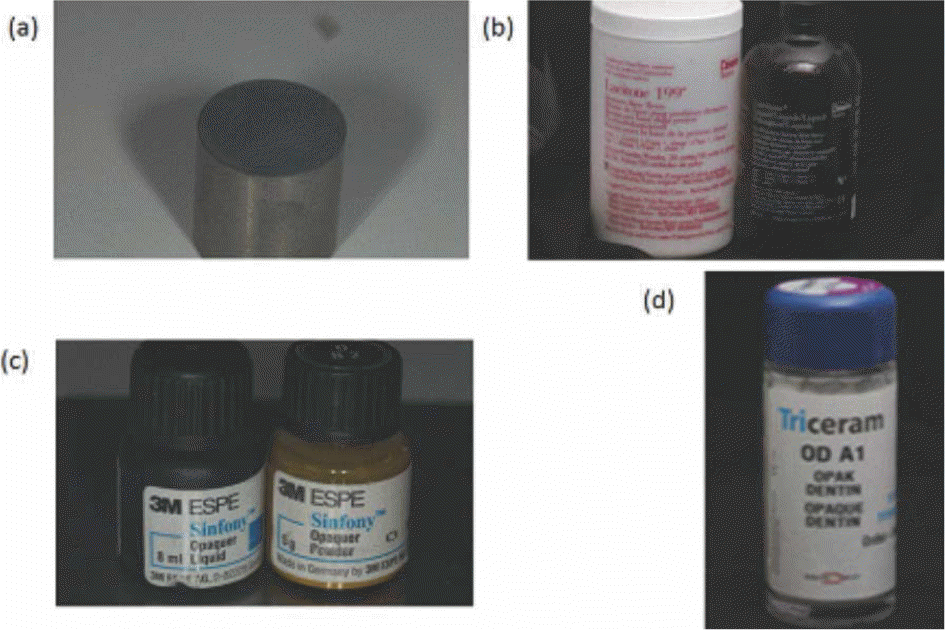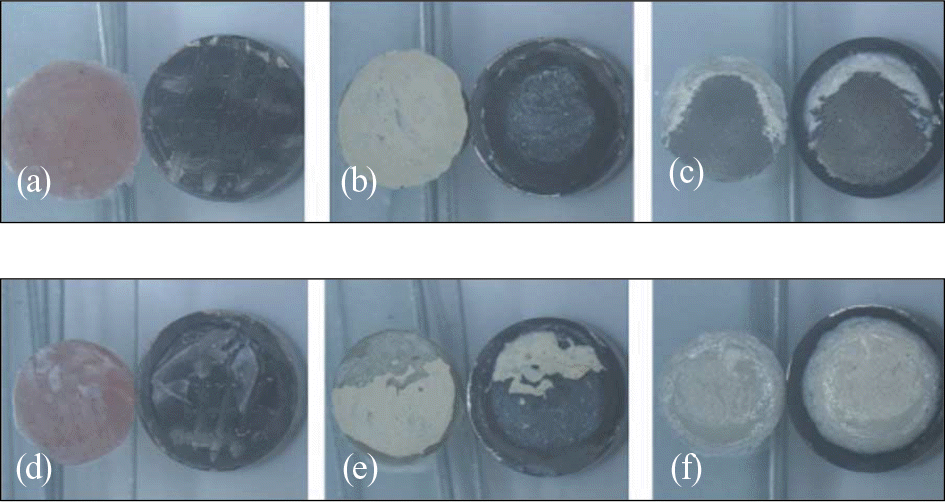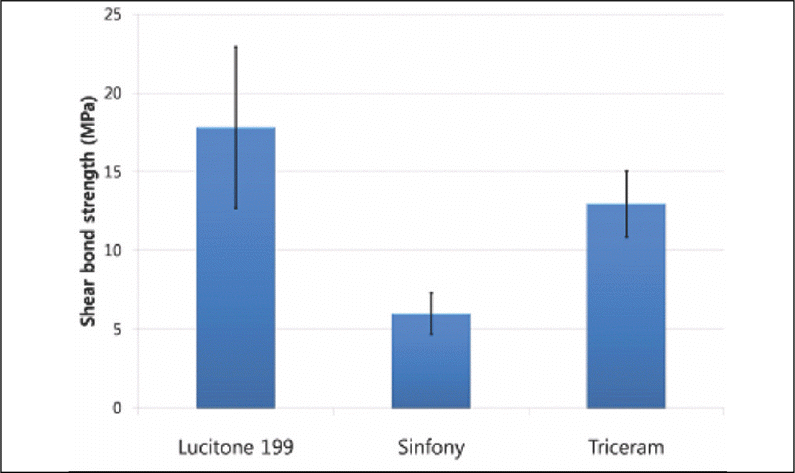Abstract
Statement of problem
Recently, titanium has become popular as superstructure material in implant dentistry because titanium superstructure can be easily milled by means of computer-aided design and manufacture (CAD/CAM) technique. But retention form such as nail head or bead cannot be cut as a result of technical limitation of CAD/CAM milling and bond strength between titanium and porcelain is not as strong as that of conventional gold or metal alloy.
Purpose
The objective of this study was to evaluate the shear bond strength of three different materials: heat curing resin, composite resin, porcelain which were bonded to grade II commercially pure Titanium (CP - Ti).
Material and methods
Thirty seven CP - Ti discs with 9 mm diameter, 10 mm height were divided into three groups and were bonded with heat curing resin (Lucitone 199), indirect composite resin (Sinfony), and porcelain (Triceram) which were mounted in a former with 7 mm diameter and 1 mm height. Samples were thermocycled for 1000 cycles at between 5 - 55℃. Shear bond strength (MPa) was measured with Instron Universal Testing Machine with cross head speed of 1 mm/min. The failure pattern was observed at the fractured surface and divided into adhesive, cohesive, and combination failure. The data were analyzed by one-way ANOVA and Scheffe's multiple range test (α = 0.05).
Results
Lucitone 199 (17.82 ± 5.13 MPa) showed the highest shear bond strength, followed by Triceram (12.97 ± 2.11 MPa), and Sinfony (6.00 ± 1.31 MPa). Most of the failure patterns in Lucitone 199 and Sinfony group were adhesive failure, whereas those in Triceram group were combination failure.
Conclusion
Heat curing resin formed the strongest bond to titanium which is used as a CAD/CAM milling block. But the bond strength is still low compared with the bond utilizing mechanical interlocking and there are many adhesive failures which suggest that more studies to enhance bond strength are needed. (J Korean Acad Prosthodont 2009;47:46-52)
Go to : 
REFERENCES
1.Taira Y., Yanagida H., Matsumura H., Yoshida K., Atsuta M., Suzuki S. Adhesive bonding of titanium with a thione-phosphate dual functional primer and self-curing luting agents. Eur J Oral Sci. 2000. 108:456–60.

2.Kasemo B. Biocompatibility of titanium implants: surface science aspects. J Prosthet Dent. 1983. 49:832–7.

3.Reclaru L., Meyer JM. Study of corrosion between a titanium implant and dental alloys. J Dent. 1994. 22:159–68.

4.Lautenschlager EP., Monaghan P. Titanium and titanium alloys as dental materials. Int Dent J. 1993. 43:245–53.
5.Cecconi BT., Koeppen RG., Phoenix RD., Cecconi ML. Casting titanium partial denture frameworks: a radiographic evaluation. J Prosthet Dent. 2002. 87:277–80.

6.Low D., Sumii T., Swain M. Thermal expansion coefficient of titanium casting. J Oral Rehabil. 2001. 28:239–42.

7.Andersson M., Bergman B., Bessing C., Ericson G., Lundquist P., Nilson H. Clinical results with titanium crowns fabricated with machine duplication and spark erosion. Acta Odontol Scand. 1989. 47:279–86.

8.Bergman B., Nilson H., Andersson M. A longitudinal clinical study of Procera ceramic-veneered titanium copings. Int J Prosthodont. 1999. 12:135–9.
9.Lovgren R., Andersson B., Carlsson GE., Odman P. Prospective clinical 5-year study of ceramic-veneered titanium restorations with the Procera system. J Prosthet Dent. 2000. 84:514–21.
10.Bonnard P., Hermans M., Adriaenssens P., Daelemans P., Malevez C. Anterior esthetic rehabilitation on teeth and dental implants optimized with Procera technology: a case report. J Esthet Restor Dent. 2001. 13:163–71.

11.Ciftci Y., Canay S., Hersek N. Shear bond strength evaluation of different veneering systems on Ni-Cr alloys. J Prosthodont. 2007. 16:31–6.
12.Ohkubo C., Watanabe I., Hosoi T., Okabe T. Shear bond strengths of polymethyl methacrylate to cast titanium and cobalt-chromium frameworks using five metal primers. J Prosthet Dent. 2000. 83:50–7.

13.Yoshida K., Kamada K., Taira Y., Atsuta M. Effect of three adhesive primers on the bond strengths of four light-activated opaque resins to noble alloy. J Oral Rehabil. 2001. 28:168–73.

14.Matsumura H., Yanagida H., Tanoue N., Atsuta M., Shimoe S. Shear bond strength of resin composite veneering material to gold alloy with varying metal surface preparations. J Prosthet Dent. 2001. 86:315–9.

15.Park SY., Jeon YC., Jeong CM. Comparison of the bond strength of ceramics fused to titanium and Ni-Cr alloy. J Korean Acad Prosthodont. 2003. 41:89–98.
16.Adachi M., Mackert JR Jr., Parry EE., Fairhurst CW. Oxide adherence and porcelain bonding to titanium and Ti-6Al-4V alloy. J Dent Res. 1990. 69:1230–5.
17.Kimura H., Horng CJ., Okazaki M., Takahashi J. Oxidation effects on porcelain-titanium interface reactions and bond strength. Dent Mater J. 1990. 9:91–9.

18.Doerr CL., Hilton TJ., Hermesch CB. Effect of thermocycling on the microleakage of conventional and resin-modified glass ionomers. Am J Dent. 1996. 9:19–21.
Go to : 
 | Fig. 1Materials used in this study. (a) Grade II CP-Ti disc, (b) Lucitone 199, (c) Sinfony, (d) Triceram |
 | Fig. 3Bonding failure patterns. (a) Lucitone 199, adhesive failure (b) Sinfony, adhesive failure (c) Triceram, combination failure (d) Lucitone 199, combination failure (e) Sinfony, combination failure (f) Triceram, cohesive failure |
Table I.
Materials used in this study
Table II.
Surface treatment conditions for experimental groups
| Material | Surface treatment | Surface conditions |
|---|---|---|
| Lucitone 199 | Retention groove | Metal primer |
| Sinfony | Rocatec | ESPE Sil |
| Triceram | Airborne-particle abrasion | Triceram bonder |
Table III.
One-way ANOVA of intergroup by Scheffe ´method
| Material (1) | Material (2) | Mean Difference (1) - (2) | Std. Error | Sig. |
|---|---|---|---|---|
| Lucitone 199 | Sinfony | 11.81973∗ | 1.2838 | .000 |
| Triceram | 4.84678∗ | 1.40199 | .006 | |
| Sinfony | Lucitone199 | -11.81973∗ | 1.2838 | .000 |
| Triceram | -6.97295∗ | 1.38004 | .000 | |
| Triceram | Lucitone199 | -4.84678∗ | 1.40199 | .006 |
| Sinfony | -6.97295∗ | 1.38004 | .000 |




 PDF
PDF ePub
ePub Citation
Citation Print
Print



 XML Download
XML Download